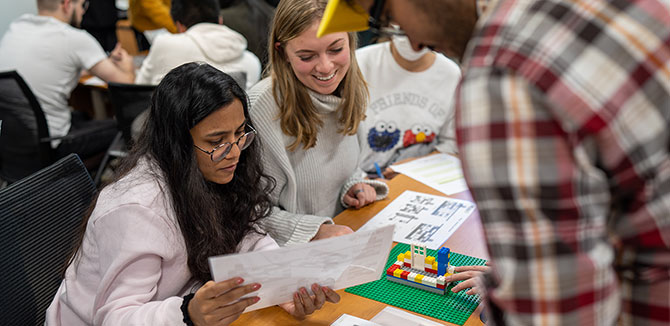Building Construction Philosophy with Legos
Afshan Barshan talks about the Last Planner Simulation and how it helped him teach fundamental concepts to MPM students in his Lean Construction course.

Lego bricks are thought of as tools for building. Afshan Barshan uses them to teach a key building philosophy.
Barshan taught Lean Construction this fall in Northwestern Engineering's Master of Science in Project Management (MPM) program, and he used Legos to help students not only understand the concept of Lean but also to see what happens when it is applied to a project.
Lean is a philosophy with origins in Japan with automaker Toyota. Barshan, senior vice president with general contracting firm Skender Construction, was part of a small group that introduced Lean practices to the Chicago construction industry in 2011.
“In its purest form, Lean is logical thinking and common sense," he said. "It has structure, and is a bit scientific, but for the most part it’s simply the right way to do things. Who wants waste in the process?”
The anti-waste message is one of the main tenets in Lean. It advocates taking what may be multiyear masterplans and breaking them down into phases of no more than 12 weeks in length. By doing things in smaller batches with more timely oversight, review, and revision, Lean helps ensure small delays do not spiral into bigger, more costly ones.
Barshan introduced the Lean philosophy to Skender more than 17 years ago. The Chicago-based builder manages the full spectrum of construction projects, from multifamily residential housing and healthcare to science labs and office towers. The firm has earned a reputation among clients for delivering renovations and new builds with a uniquely efficient experience.
Students are the right audience for the Lean message, Barshan said.
MPM deputy director Ahmad Hadavi agreed.
"Lean philosophy promotes respect for people and increasing value for customers by removing different types of wastes in projects," Hadavi said. "It focuses on process, flow, and continuous improvement."
A key feature of Barshan's course is Villego, a three-hour simulation that uses Legos and focuses on the concepts of the Last Planner System of production.
“The whole concept of Last Planner is having the people who do the work plan the work,” he said. “The person on the job site who really does it and has people doing it is the foreman. It’s not the estimator sitting back in the office. It’s certainly not the business development guy or the owner of a company.”
The Last Planner System incorporates foremen and on-site personnel into the process well before the work phase actually begins.
“Instead of just pushing the schedule on them, why not ask them to pull it?” he said. “The philosophy behind the simulation is to get students to understand the concept of pull and what pull planning is.”
To do that, students are placed in teams and given some Lego building blocks. They then are told to build a six-layer house, complete with a chimney. The first time they run through the simulation, they do it with a push philosophy that results in little to no communication among team members.
Hardly anyone ever completes the house in the allocated time, Barshan said.
Then they run the simulation again using Lean practices and a pull planning system.
“Most of them complete the house, because now they’re communicating,” he said. “They have a plan in front of them. They’re adjusting the plan. They’re learning how to collaborate, how to ask questions, and how to talk. Students see the benefits through the simulation.
“It’s a very practical class. Less theory, more practice. You need to understand why you’re doing a process, not just blindly do it.”

